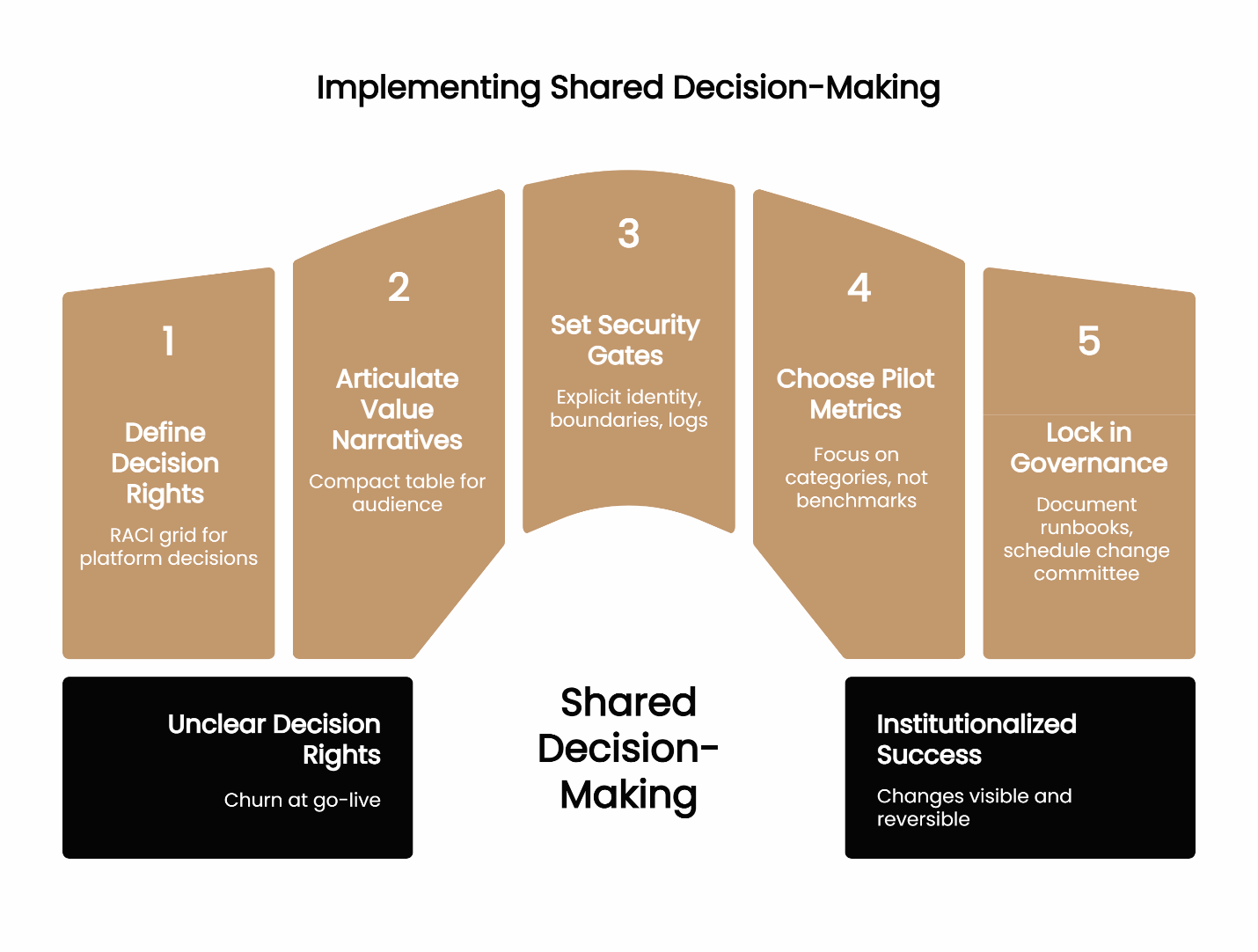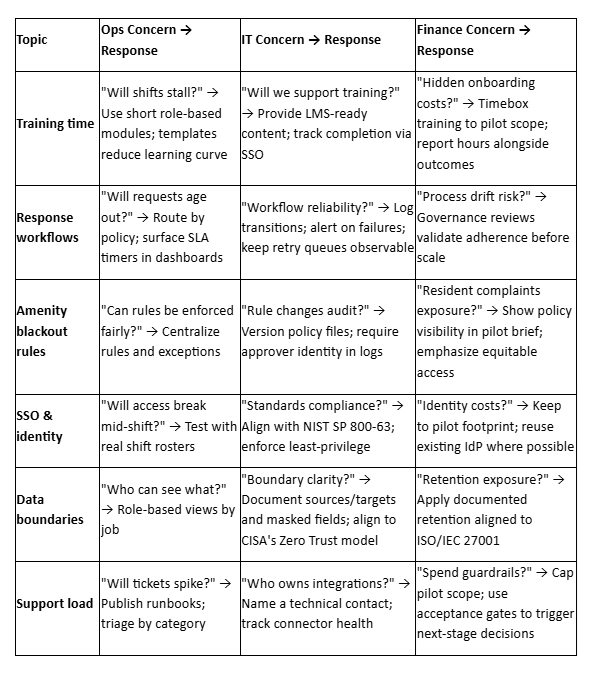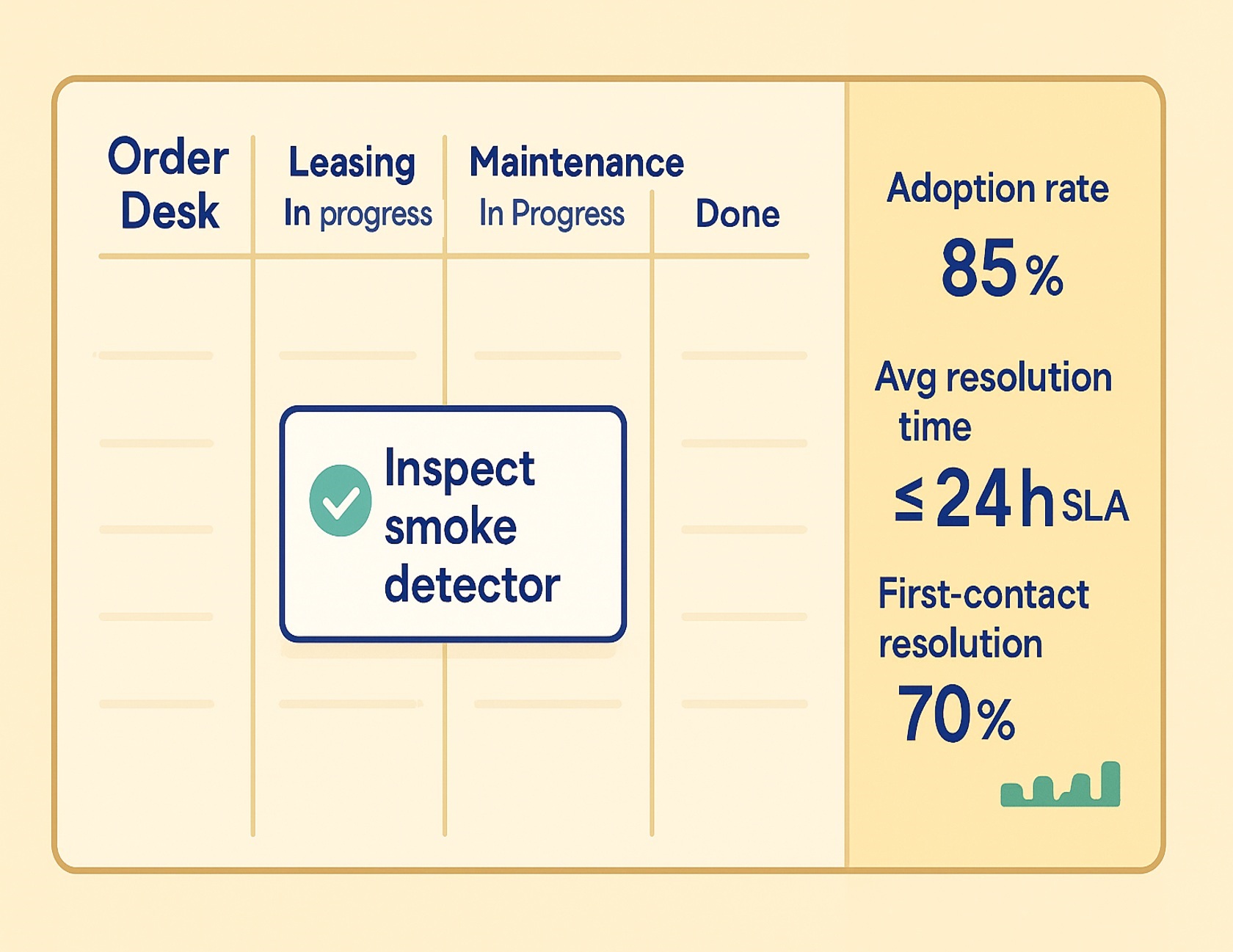
📌 Key Takeaways:
Cross-functional technology decisions require shared ownership structures rather than departmental silos to prevent implementation failures and post-launch friction.
Dual Value Narratives Accelerate Consensus: Present Operations outcomes alongside IT controls in the same framework so each stakeholder sees their priorities reflected rather than competing with other departments.
Security Gates Enable Speed, Not Restriction: Implement SSO, data boundaries, audit logs, and least-privilege access upfront so Operations teams can move faster with IT's full confidence in system integrity.
Pilot Metrics Categories Trump Hard Numbers: Focus on directional measurement categories like time-to-resolution and SLA adherence rather than specific benchmarks to de-risk budget decisions and maintain flexibility.
Governance Structures Institutionalize Success: Document runbooks, establish change committees, and create rollback procedures during pilot phase so portfolio scaling becomes systematic rather than reactive.
The Newsroom Model Creates Predictable Rhythms: Treat community operations like editorial workflows with clear approval processes and defined roles so resident touchpoints become auditable and consistent across buildings.
Structured decision-making frameworks eliminate the guesswork that kills technology initiatives before they deliver value.
For Operations champions in Class A apartment communities navigating committee-based technology evaluations, these frameworks provide the cross-functional alignment needed to secure IT and Finance buy-in for resident experience platforms.
Shared decisions beat siloed bets. Treat the community like a newsroom—cadence, approvals, and clear roles—so resident touchpoints become predictable and auditable. This five-step framework pairs Ops outcomes with IT controls, adds security gates, sets pilot-ready metric categories, and locks in governance wins. The result is alignment without guesswork.
The shared decision-making framework for deploying a Resident Experience Platform is a five-step process: define decision rights and success criteria, articulate dual value narratives (Ops outcomes vs. IT controls), set security gates (SSO, data boundaries, audit logs, least-privilege), choose pilot metric categories, and lock in governance for scale.
Why IT–Ops Alignment Matters Now in Resident Operations

Peak seasons expose the cracks: congested front desks, fairness and access complaints, visibility gaps, and missed SLAs in Class A communities. Committee-style evaluation is the norm, so teams look for frameworks, pilotable steps, and evidence-first language.
A resident experience platform unifies communications, access/amenities, and requests under roles, policies, and SLAs to create predictable rhythms and portfolio reporting. This matters because fragmented tools and ad-hoc workflows create chaos and inconsistent policy application, which leads to fairness conflicts and avoidable SLA misses. Alignment ensures the platform is implemented with shared decision rights, auditable controls, and measurable outcomes—so that adoption is de-risked and scale becomes a governance exercise rather than a fire drill.
IT will seek assurance on identity, least-privilege, and auditability. Ops will prioritize service rhythms and equitable access. Finance will ask for guardrails and a de-risked pilot before broader spend.
The Shared Decision-Making Framework

Step 1: Define Decision Rights & Success Criteria
Create a simple RACI grid for platform decisions covering identity, integrations, messaging, and amenity rules. Tie success criteria to policy visibility and SLA-related behaviors such as requests routed correctly, messages acknowledged, and amenity rules applied consistently.
Decision rights reduce churn at go-live because approvers are known and accountable, so that escalations shrink, which leads to faster stabilization after launch.
Step 2: Articulate Dual Value Narratives
Use a compact table so each audience sees itself in the plan:

Pair amenity management with identity controls so booking rules are enforced consistently while access is provable and reversible.
Step 3: Set Security Gates
Security gates preserve IT control because identity, boundaries, and logs are explicit, so that Ops can move faster, which leads to fewer production surprises and easier approvals.
Required Controls:
- SSO via approved identity provider, aligning to the NIST SP 800-63 Digital Identity Guidelines for assurance categories
- Data boundaries documented by purpose and system; connectors scoped to least data necessary, consistent with the CISA Zero Trust Maturity Model
- Audit logs for administrative actions and policy changes; retention aligned to governance needs under ISO/IEC 27001
- Least-privilege role design with periodic access reviews
Step 4: Choose Pilot Metrics Categories
Focus on categories rather than benchmarks:
- Time-to-resolution (TTR) for requests
- SLA adherence for core workflows
- Message read-rates for critical communications
- Variance reduction across buildings or shifts
These categories de-risk the spend because they show directional movement without premature ROI math, so that Finance can judge readiness, which leads to confident scale decisions.
Step 5: Lock in Governance Wins
Document runbooks, schedule a weekly change committee during the pilot, define a rollback path, and version communication templates. Governance institutionalizes success because changes are visible and reversible, so that risks are contained, which leads to smoother portfolio rollout.
2×2 Priorities Matrix: Operations vs IT Perspective
Axes: Resident Impact (low→high) × Risk/Complexity (low→high)

Place early pilot scope in Quick Wins; use Foundation First items to satisfy IT before attempting Scale Candidates.
Pilot Plan and Timeline
Scope: One building, one peak cycle. Begin with high-traffic amenities and front-desk communications to maximize observable signals.
Change windows: Deploy off-peak; pre-stage rollbacks.
Acceptance gates: Security sign-off completed; message read-rates meet the agreed threshold; SLA variance trends in the right direction.
Reporting cadence: Weekly pilot report; end-of-cycle decision brief with recommendations.
Pilots succeed when governance meetings are short, artifacts are versioned, and success criteria map to agreed metric categories rather than hard numbers.
Common Concerns and Responses

Next Steps and Resources
The shared decision-making framework transforms platform deployment from a technology project into an organizational capability. By addressing each stakeholder's core concerns while maintaining focus on resident outcomes, Operations champions can build the cross-functional consensus needed for successful implementation and portfolio scaling.
Related Resources:
- Integrating Resident Apps with Existing Property Management Software: A Complete Guide
- Seamless Resident App Implementation: A Step-by-Step Guide for Property Management Teams
- Measuring Amenity Success: Key Metrics for Property Managers
For operational context and industry advocacy, the National Multifamily Housing Council provides valuable resources on multifamily operational rhythms and best practices.
Frequently Asked Questions
What are the minimum security requirements for IT?
SSO, defined data boundaries, and audit logs with role-based access—consistent with widely accepted security practice and aligned to guidance from NIST, CISA's Zero Trust model, and ISO/IEC 27001.
How long should the pilot run?
One full peak-period cycle to validate SLA adherence and message read-rates. This timing reflects common multifamily operational rhythms and is broadly supported by industry practice.
How do we prove value to Finance at this stage?
Share pilot metric categories and governance commitments—no ROI math at this stage. The emphasis is on directional evidence and risk reduction rather than numerical promises.
About ElevateOS
ElevateOS partners with Class A communities to deliver comprehensive resident experience solutions that unify operations, enhance resident satisfaction, and support portfolio growth through integrated technology and service delivery.

.avif)


